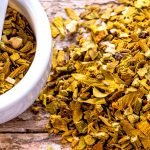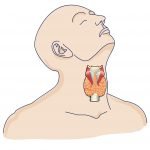Metabolic Syndrome: Treating with Diet, Exercise and Insulin-Supportive Herbs
Lise Naugle, ND
James L. Wilson, ND, PhD
Metabolic Syndrome (MetS) is a well-known concept used to describe an aggregation of risk factors including hyperglycemia, dyslipidemia, high blood pressure, and central obesity. Despite some disagreement on its exact definition,1 the lack of understanding of its specific pathogenesis, and the question of whether the associated signs and symptoms yield any more risk than the sum of the individual parts,2 this constellation of symptoms has proven to be a very useful clinical tool. MetS is associated with a proinflammatory and prothrombotic state which increases an individual’s risk of type 2 diabetes mellitus3 and cardiovascular disease.4 Early detection and treatment may prevent progression to more serious pathology.
The most commonly used diagnostic criteria for MetS is that of The National Education Program’s Adult Treatment Panel III (NCEP/ATP III). The ATP III defines MetS as the presence of at least 3 of the following clinical signs5:
- Blood pressure >130/85 mm Hg*
- Plasma triglycerides > 150 mg/dL*
- HDL-cholesterol (HDL-C) <40 mg/dl in men and <50 mg/dL in women*
- Waist circumference >40 inches in men and >35 inches in women
- Fasting blood glucose > 110 mg/dL*
* If any of the clinical laboratory measurements are outside the normal range, the tests should be repeated and confirmed before making a diagnosis.
Other organizations, including the World Health Organization (WHO), the American Association of Clinical Endocrinology (AACE), and the European Group for the Study of Insulin Resistance (EGIR) have similar definitions with minor variations. Some important differences are the WHO’s inclusion of microalbuminuria > 20µg/min.6 Microalbuminuria, or tiny amounts of albumin detected in the urine, is an independent predictor of cardiovascular events and all-cause mortality in MetS.7 EGIR’s inclusion of elevated fasting insulin levels adds an important diagnostic and therapeutic element, ie, insulin resistance (IR), to the accuracy of the diagnosis.8 IR is a condition in which cells fail to respond to insulin at its normal circulating levels. Insulin is required for glucose absorption. IR is one of the first measurable abnormalities in people who later develop type 2 diabetes, IR promotes many associated pathologies, and IR is the hallmark of MetS.9 Although numerous underlying risk factors precipitate the development of MetS – including physical inactivity, hormonal imbalance, and genetic predisposition – IR and abdominal obesity appear to be the most important.10
Incidence
The incidence of MetS is widespread. An analysis of NHANES III data from 1998-1994, using the criteria later adopted by NCEP/ATP III, suggested an overall prevalence of MetS in the United States to be 21.8%.11 The prevalence of MetS in participants aged 60-69 years rose to 43.5%, compared to 6.7% among people 20-29 years old.A more recent estimate,12 from data collected from 2003-2006 and using the NCEP/ATP III definition, suggests that 34% of people in the United States meet the criteria. However, the prevalence of MetS varies somewhat by gender and ethnicity and considerably by age.
Diagnosis and Treatment
Diagnosis is made by repeated elevations of the same 3 of the 5 indicators listed above.5,13 Intra-abdominal fat (IAF) has been independently associated with all 5 MetS criteria.13 Adding IR as a separate diagnosis increases the accuracy of the diagnosis, especially among the obese.14 Using the Homeostasis Model Assessment of IR (HOMA-IR), IR is diagnosed by fasting insulin levels of >3.16 µIU/mL or a fasting insulin:glucose ratio (also known as FIGR) of less than 7.14 Clinically, the best and easiest way to identify IR in individuals with a fasting plasma glucose of <6.4 mmol/L is the presence of visceral adiposity along with the NCEP criteria of elevated triglycerides and waist circumference.13
Diet and exercise have been shown to be important tools in the treatment of MetS. A meta-analysis15 of 34 studies found that for type 2 diabetics, aerobic exercise alone or in combination with resistance training at least 2 times per week at 60-85% of maximum heart rate results in a statistically significant improvement in several factors associated with MetS, including glycemic control, triglyceride levels, systolic blood pressure, and waist circumference. In healthy individuals, 30-60 minutes of moderate physical exercise 5 days a week was also found to result in improved insulin sensitivity and lipid profiles, and a decrease in MetS components compared to controls.16
Several dietary approaches have been shown to be beneficial, though there is yet to be universal agreement on a single dietary approach. However, most authorities agree that reducing refined carbohydrates, such as white flour and sugar, is crucial. In one study17 of obese men and women with MetS, participants were assigned to 1 of 2 hypocaloric diets: one with primarily whole grains or one with refined grains. Body weight decreased significantly in each group. Waist circumference, body fat percentage and cholesterol levels also decreased in each group, but the whole-grain group had a significantly greater decrease in body fat percentage. In addition, the whole-grain group experienced significantly greater reductions in the level of high sensitivity C-reactive protein (hs-CRP), an inflammatory marker and important predictor of cardiovascular events.
A randomized, single-blind trial18 tested the effects of a Mediterranean-style diet on patients with MetS. Patients in a control group were advised to eat a modest diet of 50-60% carbohydrates, 15-20% protein, and less than 30% fat. Patients in the Mediterranean-style diet group were asked to eat a diet within the same macronutrient parameters, with the additional recommendations to limit saturated fat to less than 10% and cholesterol to less than 300 mg per day, and to increase their consumption of whole grains, fruits, vegetables, walnuts, and olive oil. Patients who ate the Mediterranean-style diet had significantly reduced proinflammatory cytokines, as well as hs-CRP. In addition, their endothelial function improved and they had decreased IR compared to controls.
In addition to lifestyle and dietary modifications, there are a number of herbs that can be used to increase insulin sensitivity and help normalize blood glucose levels. Several of these have been studied specifically for their effects on MetS. It is the author’s (JW) experience that their therapeutic effects are increased when used in combination.
Cinnamomum cassia and Cinnamomum verum
Cinnamon (both cassia and verum forms) was the most effective of 49 medicinal herbs, spices and plants evaluated for their insulin-like actions or insulin-potentiating ability on rat adipocytes in vitro.19 Cinnamon appears to potentiate insulin action by enhancing insulin signaling pathways and stimulating glucose uptake.20
Human studies are encouraging as well. One crossover experiment21 looked at the effect of 6 grams of ground cinnamon ingestion versus control on postprandial glycemic response in both normal-weight and obese subjects. The consumption of cinnamon significantly reduced the 120-minute glucose area under the curve (24%) as well as blood glucose at 15, 30 and 45 minutes, though blood sugar did rise at 120 minutes. The authors suggested that cinnamon may be effective at modulating glucose response in normal and obese individuals.
A single-blind, randomized, crossover study of healthy adults showed that ingestion of 3 grams per day of Cinnamomum cassia for 14 days resulted in improved glycemic control and insulin sensitivity, although the improvements were not sustained after the cinnamon intake was stopped.22 In a placebo-controlled pilot study,23 women with polycystic ovarian syndrome, (a disorder associated with IR) were given either placebo or 333 mg cinnamon TID (approximately 1 gm/day) for 8 weeks. Significant reductions in fasting glucose and IR occurred in the cinnamon group, apparently facilitated through an increase in glucose utilization. A review article written in 2010 reports that cinnamon or its constituents have beneficial effects on multiple factors associated with MetS, including serum glucose and lipids, IR, inflammation, antioxidants, blood pressure, and body weight.24
Gymnema sylvestre
Gymnema is a traditional medicinal plant native to the tropical forests of India. It has been used historically to treat blood sugar disorders, and chewing the leaves actually suppresses the ability to taste sweetness. Gymnema has the ability to inhibit glucose absorption in the intestines in guinea pigs and Wistar rats,25 and has been demonstrated to restore the architecture and function of the insulin-producing pancreatic beta cells in an animal model of diabetes using Wistar rats.26
Type 2 diabetics who took an extract of gymnema orally for 18-20 months along with conventional drugs showed significant reductions in blood sugar levels and glycosylated end-products compared to patients taking conventional drugs alone.27 The patients taking gymnema were able to reduce their conventional drug dosage. In fact, 5 of the 22 patients were able to discontinue their drugs and maintain their blood glucose using only the extract. In another study,28 oral administration of a gymnema extract to insulin-dependent diabetics resulted in decreases in insulin requirements, fasting blood glucose, glycosylated hemoglobin (HbA1c), and glycosylated plasma proteins. Serum lipids returned to near-normal levels and there was evidence of direct regeneration of pancreatic beta cells. Patients who were treated only with insulin did not show any significant reduction in HbA1c, glycosylated plasma proteins, or serum lipids.
Momordica charantia
A review of over 100 studies of momordica, also known as bitter melon or bitter gourd, has shown its use as a medicinal agent, particularly in the treatment of diabetes and its complications.29 In an animal model of diabetes using Wistar rats, momordica demonstrated a number of benefits, including significant improvements in fasting blood glucose, serum insulin and beta cell function.30 In a model of MetS using Zucker rats,31 momordica significantly reduced serum total cholesterol and LDL-C levels, significantly increased HDL-C levels, and reduced hepatic lipids. It also significantly lowered expression of the proinflammatory mediator, NF-kappa B (thereby offering cardio-protective effects), and reduced glucose to a level similar to that of healthy rats.
In a human trial,32 men and women with MetS were given 4.8 gm of momordica as freeze-dried, powdered, whole plant daily for 3 months. At the end of 3 months, patients taking momordica showed a significant decrease in waist circumference and a non-significant decrease in indicators of IR. The authors reported an overall 19% decrease in MetS and believe that their study provides justification for a double-blind, placebo-controlled trial in the future.
Trigonella foenum-graecum
Trigonella, or fenugreek, is often used in various cuisines and has also proven to be valuable as a medicinal plant. One study33 examined trigonella’s effect on both the development of diabetes in healthy mice fed a high-fat diet and the progression of disease in mice with established diabetes. In both groups, it had an anti-diabetic effect, decreasing blood glucose levels, IR and triglycerides. In an animal model of MetS using Wistar rats,34 trigonella significantly reduced hyperglycemia, hyperlipidemia, elevations in atherogenic markers, oxidative stress, and impairments of liver function.
A double-blind, placebo-controlled study was conducted on humans with mild-to-moderate type 2 diabetes. One group received 1 gm/day of an alcohol extract of the seeds, while the other group was given a placebo and instructions in dietary planning. At the end of 2 months, the trigonella group showed significantly lower insulin and area under the curve of blood glucose, a significant increase in HDL-C, a reduction in serum triglycerides, and a decrease in IR.35
Tinospora cordifolia
Tinospora, sometimes known as guduchi or gulvel, is a climbing shrub found in India. It is highly valued in traditional Ayurvedic medicine for its tonic and immune-supportive properties. It can also be helpful with associated metabolic imbalances. Animal studies with Wistar rats have shown a significant anti-hyperglycemic effect in mild-to-moderate hyperglycemia,36 as well as beneficial effects on fructose-induced hyperinsulinemia, hypertriglyceridemia, and oxidative stress.37 The herb is recommended for people who have metabolic disorders including insulin resistance and diabetes.37
Eugenia jambolana
Eugenia jambolana, also called black plum, jamun or jambul, is an herb used in traditional Ayurvedic medicine to treat diabetes. In an animal study with albino Wistar rats, the seeds showed the ability to significantly reduce blood sugar, serum triglycerides and LDL-C.38 The fruit pulp also exhibited anti-hyperglycemic activity in diabetic rabbits.39,40
Although the etiology of obesity-induced IR is multifactorial and complex, it is the primary factor underlying the current epidemics of MetS and type 2 diabetes.41 Treatment should begin with aerobic exercise at least twice a week at 60-85% maximum heart rate15 for approximately 40 minutes plus dietary interventions. Suggested dietary modifications include reduction of refined carbohydrates, saturated fats, trans fats and calories, while increasing whole grains, vegetables, fruits, nuts and olive oil. In addition to lifestyle modifications, medicinal plants such as cinnamon, gymnema, momordica, trigonella, tinospora, and eugenia – alone or preferably in combination – can be effective herbal therapies to improve glycemic control and insulin sensitivity and reduce additional risk factors for MetS.

Lise Naugle, ND, the Director of Clinical Support and Education at ICA Health, provides consultations to healthcare professionals on clinical assessment and treatment of difficult cases related to stress and hypothalamus-pituitary-adrenal axis dysfunction. Using the latest research in endocrinology, botanical medicines and nutrition, she creates educational materials and presentations for physicians and the public. Dr Naugle is a graduate of Bastyr University, and was in private practice for 11 years.
***

James Wilson, ND, PhD is the author of Adrenal Fatigue: The 21st Century Stress Syndrome and is an internationally recognized lecturer and authority on stress. He coined the term ‘adrenal fatigue’ and was the first to present it as a distinct, diagnosable syndrome. One of the founders of the Canadian College of Naturopathic Medicine, he has been a trailblazer for naturopathic medicine for over 3 decades. Dr. Wilson is the founder and product formulator for ICA Health, a company that focuses on dietary supplements and clinical solutions for stress.
References
- Houston MC, Basile J, Bestermann WH, et al. Addressing the global cardiovascular risk of hypertension, dyslipidemia, and insulin resistance in the southeastern United States. Am J Med Sci. 2005;329(6):276-291.
- Kahn R, Buse J, Ferrannini E, et al. The metabolic syndrome: time for a critical appraisal: joint statement from the American Diabetes Association and the European Association for the Study of Diabetes. Diabetes Care. 2005;28(9):2289-2304.
- Ford ES, Li C, Sattar N. Metabolic syndrome and incident diabetes: current state of the evidence. Diabetes Care. 2008;31:1898-1904.
- Giugliano D, Ceriello A, Esposito K. The effects of diet on inflammation: emphasis on the metabolic syndrome. J Am Coll Cardiol. 2006;48:677-685.
- Executive Summary of The Third Report of The National Cholesterol Education Program (NCEP) Expert Panel on Detection, Evaluation, And Treatment of High Blood Cholesterol In Adults (Adult Treatment Panel III). JAMA. 2001;285(19):2486-2497.
- Alberti KG, Zimmet PZ. Definition, diagnosis and classification of diabetes mellitus and its complications. Part 1: diagnosis and classification of diabetes mellitus provisional report of a WHO consultation. Diabet Med. 1998;15(7):539-553.
- Yuyun MF, Adler AI, Wareham NJ. What is the evidence that microalbuminuria is a predictor of cardiovascular disease events? Curr Opin Nephrol Hypertens. 2005;14(3):271-276.
- Balkau B, Charles MA. Comment on the provisional report from the WHO consultation. European Group for the Study of Insulin Resistance (EGIR) Diabet Med. 1999;16:442–443.
- Goldstein BJ. Insulin resistance as the core defect in type 2 diabetes mellitus. Am J Cardiol. 2002;90(5A):3G-10G.
- Grundy SM, Cleeman JI, Daniels SR, et. al. Diagnosis and management of the metabolic syndrome: an American Heart Association/National Heart, Lung, and Blood Institute scientific statement: Executive Summary. Crit Pathw Cardiol. 2005;4(4):198-203.
- Ervin RB. Prevalence of metabolic syndrome among adults 20 years of age and over, by sex, age, race and ethnicity, and body mass index: United States, 2003-2006. Natl Health Stat Report. 2009;(13):1-7.
- Ford ES, Giles WH, Dietz WH. Prevalence of the metabolic syndrome among US adults: findings from the third National Health and Nutrition Examination Survey. JAMA. 2002;287(3):356-359.
- Carr DB, Utzschneider KM, Hull RL, et.al. Intra-abdominal fat is a major determinant of the National Cholesterol Education Program Adult Treatment Panel III criteria for the metabolic syndrome. Diabetes. 2004;53(8):2087-2094.
- Kurtoglu S, Akin L, Kendirci M, et al. The absence of insulin resistance in metabolic syndrome definition leads to underdiagnosing of metabolic risk in obese patients. Eur J Pediatr. 2012;171(9):1331-1337.
- Chudyk A, Petrella RJ. Effects of exercise on cardiovascular risk factors in type 2 diabetes: a meta-analysis. Diabetes Care. 2011;34(5):1228-37.
- Caro J, Navarro I, Romero P, et al. Metabolic effects of regular phisical exercise in healthy population. Endocrinol Nutr. 2013;60(4):167-172.
- Katcher HI, Legro RS, Kunselman AR, et al. The effects of a whole grain-enriched hypocaloric diet on cardiovascular disease risk factors in men and women with metabolic syndrome. Am J Clin Nutr. 2008;87(1):79-90.
- Esposito K, Marfella R, Ciotola M, et al. Effect of a Mediterranean-style diet on endothelial dysfunction and markers of vascular inflammation in the metabolic syndrome: a randomized trial. JAMA. 2004;292(12):1440-1446.
- Broadhurst CL, Polansky MM, Anderson RA. Insulin-like biological activity of culinary and medicinal plant aqueous extracts in vitro. J Agric Food Chem. 2000;48(3):849-852.
- Qin B, Nagasaki M, Ren M, et al. Cinnamon extract (traditional herb) potentiates in vivo insulin-regulated glucose utilization via enhancing insulin signalling in rats. Diabetes Res Clin Pract. 2003;62(3):139-148.
- Magistrelli A, Chezem JC. Effect of ground cinnamon on postprandial blood glucose concentration in normal-weight and obese adults. J Acad Nutr Diet. 2012;112(11):1806-1809.
- Solomon TP, Blannin AK. Changes in glucose tolerance and insulin sensitivity following 2 weeks of daily cinnamon ingestion in healthy humans. Eur J Appl Physiol. 2009;105(6):969-976.
- Wang JG, Anderson RA, Graham GM 3rd, et al.The effect of cinnamon extract on insulin resistance parameters in polycystic ovary syndrome: a pilot study. Fertil Steril. 2007;88(1):240-243.
- Qin B, Panickar KS, Anderson RA. Cinnamon: potential role in the prevention of insulin resistance, metabolic syndrome, and type 2 diabetes. J Diabetes Sci Technol. 2010;4(3):685-693.
- Shimizu K, Iino A, Nakajima J, et al. Suppression of glucose absorption by some fractions extracted from Gymnema sylvestre leaves. J Vet Med Sci. 1997;59(4):245-251.
- Ahmed AB, Rao AS Rao MV. In vitro callus and in vivo leaf extract of Gymnema sylvestre stimulate β-cells regeneration and anti-diabetic activity in Wistar rats. Phytomedicine. 2010;17(13):1033-1039.
- Baskaran K, Kizar Ahamath B, Radha Shanmugasundaram K, et. al.. Effects of a leaf extract from Gymnema sylvestre in non-insulin-dependent diabetes mellitus patients. J Ethnopharmacol. 1990;30(3):295-300.
- Shanmugasundaram ER, Rajeswari G, Baskaran K, et al. Use of Gymnema sylvestre leaf extract in the control of blood glucose in insulin-dependent diabetes mellitus. J Ethnopharmacol. 1990;30(3):281-294.
- Grover JK, Yadav SP. Pharmacological actions and potential uses of Momordica charantia: a review. J Ethnopharmacol. 2004;93(1):123-132.
- Hafizur RM, Kabir N, Chishti S. Modulation of pancreatic β-cells in neonatally streptozotocin-induced type 2 diabetic rats by the ethanolic extract of Momordica charantia fruit pulp. Nat Prod Res. 2011;25(4):353-367.
- Gadang V, Gilbert W, Hettiararchchy N, et al. Dietary bitter melon seed increases peroxisome proliferator-activated receptor-γ gene expression in adipose tissue, down-regulates the nuclear factor-κB expression, and alleviates the symptoms associated with metabolic syndrome. J Med Food. 2011;14(1-2):86-93.
- Tsai CH, Chen EC, Tsay HS, Huang CJ. Wild bitter gourd improves Metabolic syndrome: a preliminary dietary supplementation trial. Nutr J. 2012;11:4.
- Hamza N, Berke B, Cheze C, et al. Preventive and curative effect of Trigonella foenum-graecum L. seeds in C57BL/6J models of type 2 diabetes induced by high-fat diet. J Ethnopharmacol. 2012;142(2):516-22.
- Ramadan G, El-Beih NM, Abd El-Kareem HF. Anti-metabolic syndrome and immunostimulant activities of Egyptian fenugreek seeds in diabetic/obese and immunosuppressive rat models. Br J Nutr. 2011;105(7):995-1004.
- Gupta A, Gupta R, Lal B. Effect of Trigonella foenum-graecum (fenugreek) seeds on glycaemic control and insulin resistance in type 2 diabetes mellitus: a double blind placebo controlled study. J Assoc Physicians India. 2001;49:1057-1061.
- Grover JK, Vats V, Rathi SS. Anti-hyperglycemic effect of Eugenia jambolana and Tinospora cordifolia in experimental diabetes and their effects on key metabolic enzymes involved in carbohydrate metabolism. J Ethnopharmacol. 2000;73(3):461-470.
- Reddy SS, Ramatholisamma P, Karuna R, Saralakumari D. Preventive effect of Tinospora cordifolia against high-fructose diet-induced insulin resistance and oxidative stress in male Wistar rats. Food Chem Toxicol. 2009;47(9):2224-2229.
- Sharma B, Balomajumder C, Roy P. Hypoglycemic and hypolipidemic effects of flavonoid rich extract from Eugenia jambolana seeds on streptozotocin induced diabetic rats. Food Chem Toxicol. 2008;46(7):2376-2383.
- Sharma SB, Nasir A, Prabhu KM, Murthy PS Antihyperglycemic effect of the fruit-pulp of Eugenia jambolana in experimental diabetes mellitus. J Ethnopharmacol. 2006;104(3):367-373.
- Achrekar S, Kaklij GS, Pote MS, Kelkar SM. Hypoglycemic activity of Eugenia jambolana and Ficus bengalensis: mechanism of action. In Vivo. 1991;5(2):143-147.
- Johnson AM, Olefsky JM. The origins and drivers of insulin resistance. Cell. 2013;152(4):673-684.









